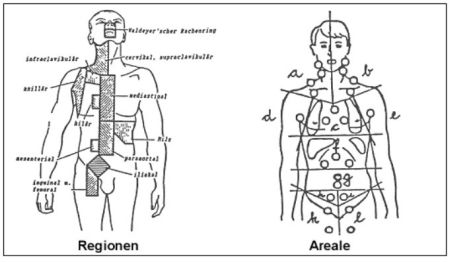Disease Stages and Risk Factors
Disease Stages
When all information gained from the histologic and diagnostic examinations are available, the lymphoma spread throughout the body can be determined and classified. The classification is based upon the Ann-Arbor staging system.
Ann Arbor classification (lymphoma spread)
| Stage I | Nodal involvement in a single lymph node region or a single localized extranodal involvement (outside the lymphatic system) |
| Stage II | Nodal involvement in two or more lymph node regions on one side of the diaphragm or localized extranodal involvements (outside the lymphatic system) in two or more regions on one side of the diaphragm |
| Stage III | Nodal involvement of two or more lymph node regions and/or involvement of organs outside the lymphatic system on both sides of the diaphragm |
| Stage IV | Not localized, diffuse and disseminated involvement of one or more extralymphatic organs with or without involvement of lymphatic tissue |
| Suffix A | No detectable B-symptoms |
| Suffix B | B-symptoms are present (fever > 38°C and/or night sweats and/or weight loss) |
The lymphatic system includes lymph nodes, spleen, thymus, Waldeyer’s tonsillar ring, appendix and Peyer’s patches.
Risk Groups
Apart from histology and tumor spread, precisely defined risk factors play an important role in the trials of GHSG.
These risk factors include:
- Presence of a large mediastinal mass, measured by means of a chest X-ray image; the mediastinal mass is considered as large if it measures at least one third of the transverse diameter of the thorax.
- Extranodal disease, i.e. any tumor spread involving other tissues than those of the lymph nodes, spleen, thymus, Waldeyer’s tonsillar ring, appendix and Peyer’s patches.
- High erythrocyte sedimentation rate (ESR) of 50mm/h if A-symptoms are present, and 30mm/h if B-symptoms are present.
- Involvement of three or more lymph node areas. Lymph node areas do not correspond to the lymph node regions according to the Ann Arbor classification system (a lymph node area may include several lymph node regions).

Regions Areas
The GHSG’s risk group classification system
On the basis of the risk factors mentioned above, the GHSG uses the following classification of risk groups in Hodgkin lymphoma patients. The treatment to be chosen is dependent on these risk groups:
Early stages
- Stage IA or IB and IIA or IIB according to Ann Arbor without risk factors
Intermediate stages
- Stage IA or IB and stage IIA with one or more risk factors
- Stage IIB if a high ESR and/or ≥ 3 involved lymph node areas are present as risk factors
Advanced stages
- Stage IIB if extranodal disease (E-lesions) and/or large mediastinal mass are present as risk factors
- Stage IIIA or IIIB
- Stage IVA or IVB